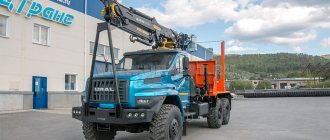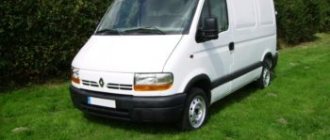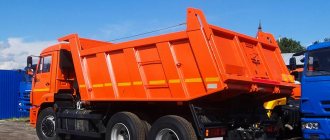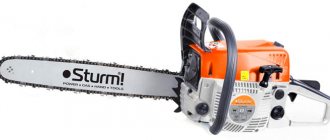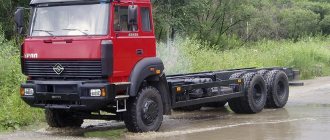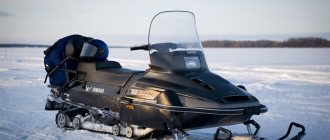Vehicles for fighting fires in residential and industrial premises, as well as in open spaces, are built on the basis of trucks. The Fireman Ural began to be produced on the basis of the 375 gasoline chassis. Subsequently, 2 and 3-axle vehicles with an economical and powerful diesel engine began to be used.
The lineup
An early model of a fire tank is the Ural AC-40 or PM-102, built on a Model 375E chassis. The fire pump is located in the driver's cabin; the suction pipes are located under the running boards on both sides of the vehicle. Above there are outlets of the pressure lines to which the hoses are connected. The crew of the fire truck is located in a twin cabin. A barrel is installed on the roof to supply extinguishing agent to the fire site.
The AC 3.0 40 vehicle on the Ural-43206 has a combat crew consisting of 6 people. The capacity of the steel tank is 3000 liters; an additional tank for a foaming agent is installed, designed for 180 liters of liquid. A centrifugal pump and distribution unit are installed in the aft part of the superstructure.
On the basis of the Ural-4320, the AC 8.0 40 tank was produced, designed for 8000 liters of water and 500 liters of foam concentrate. The pumping station is located in the cabin for the combat crew, consisting of 6 people. There is a modification AC 10.0 70, which has a water supply of 10,000 liters on board. Due to the installation of increased containers and additional equipment, the crew was reduced to 3 people.
The fire tanker model AC 5.5-40 is equipped with an all-metal twin cabin with 4 doors. The rear section of the cabin is widened, allowing for increased capacity. The front row is equipped with a driver's seat and a separate sofa for 2 people. The rear deck is designed for 4 crew members. The backs of special seats have niches for storing breathing apparatus.
Behind the cabin there is a storage compartment for 360 liters of foaming composition and a tank designed for 5500 liters of water. The upper part of the superstructure is treated with a special rubber coating. The design uses an electronic module that allows you to evaluate the supply of liquid and composition on board. A pumping unit is installed at the rear of the machine, driven by the gearbox of the base chassis. The pump supplies up to 40 liters of extinguishing agent per second under excess pressure.
On the basis of Ural trucks, it is possible to install sliding stairs. An example of such an installation is the ACL 6.0 50/4 18 machine. There is a supply of water (6000 l) and foam concentrate (400 l) on board. The mixture is supplied by an imported pump supplied by the German company Jonstadt. On the roof of the superstructure there is a staircase consisting of several sections. The maximum height reach is 18 m.
Auto pump – AMO F-15 line – 1930
In pre-revolutionary Russia, special horse-drawn carts were used to extinguish fires. A little later, fire trucks were made on foreign chassis, and the first completely Soviet fire truck was a Leningrad pump truck built in 1926 on the AMO F-15 chassis. It was equipped with a rotary pump with a capacity of 600 l/min, driven by an engine, a three-legged ladder, an assault ladder, pressure hoses, entrenching tools and some other equipment.
The car that was shown at the exhibition was made a little later - in 1930 - at the Miussky fire-fighting equipment plant in Moscow. Until 1947, it was attached to the Moscow Fine Cloth Factory named after Pyotr Alekseev, after which it became part of the collection of the Polytechnic Museum in Moscow. To this day, of the more than 300 AMO F-15 Promet produced, only two copies have survived.
Device
When creating a fire truck, the main elements of the Ural base chassis (engine, transmission, chassis) remain unchanged. Some elements can be modernized. For example, an additional heat exchanger is introduced into the cooling system of the power unit or a new radiator with an increased area is installed. This modification ensures long-term operation of the engine in the summer. When building machines, a modular principle is used, which makes it possible to re-equip the equipment.
To supply water from a third-party container, a centrifugal pump is used, the design of which includes a gas-jet vacuum apparatus.
The device is powered by exhaust gases, which are additionally used to heat the pump body and water tank. Numerous modifications are made to the chassis electrical system, including the installation of an additional cabin, light signaling and electronic controls.
An all-metal compartment for additional members of the combat crew is attached to the base chassis cabin. The standard rear wall of the cabin is removed completely or partially. Above the rear axles there are tanks for water and foam concentrate. For the manufacture of tanks, steel with a special coating that resists corrosion is used. Along the tanks there is a structure that forms compartments for installing fire-fighting equipment. Additional devices are also located on the roof of the superstructure.
A power take-off gearbox is installed on the base chassis gearbox, which is controlled from the cab. A cardan transmission is mounted between the output shaft of the gearbox and the centrifugal pump, which can consist of several parts with intermediate supports. If the pumping station is located at the rear, then the control rods for the vehicle’s clutch and throttle assembly or fuel injection pump rack are also output there.
The fire-fighting equipment includes generator sets, a retractable lighting mast, and portable spotlights. It is possible to place emergency rescue equipment with a hydraulic drive.
Tank truck PMZ-11 on ZIS-5 chassis - 1952
The 3-ton ZIS-5 truck was one of the most popular vehicles during the Second World War. It is not surprising that they took root in many parts of the USSR, where they were used, among other things, as fire trucks. The Topkinsky and Vargashinsky plants in total assembled about 3,000 of these tank trucks with a capacity of 1,420 liters of water and 80 liters of foam with a system for heating the liquid “cargo” with exhaust gases. Now PMZ-11 can be seen on pedestals in several cities, and at the exhibition they showed a well-preserved example on a UralZIS chassis.
Specifications
The dimensions and characteristics of the machines depend on the capacity of the tank, the model of the base chassis and additional equipment. A car of the same model can be equipped with different power plants and gearboxes. For example, on an AC 10.0 40 vehicle, built on the basis of the Ural-4320, a 230-horsepower YaMZ-6565 diesel engine or a 285-horsepower YaMZ-536 engine can be used. In this case, the maximum speed of the installation does not exceed 80 km/h (with a full load).
Parameters of the AC-6.0-40 vehicle, based on the Ural-5557 chassis:
- length - 8690 mm;
- width (along the tire sidewalls) - 2500 mm;
- height - 3280 mm;
- base - 3525 mm;
- rear bogie base - 1400 mm;
- approach angle - 35°;
- departure angle - 27°;
- rear overhang length - 2275 mm;
- tire size - 425/85R21;
- curb weight of the vehicle - 17485 mm.
The car uses a 4-stroke diesel engine YaMZ-65654 with a turbocharger, developing a power of 230 hp. With. The motor is equipped with an electronic control unit and complies with Euro 4 requirements.
Auto pump PMZ-18 on ZIS-150 chassis - 1955
In the 50-60s, the PMZ-18 motor pump was the most popular Soviet firefighting vehicle. But for some reason, only this single specimen, discovered on one of the collective farms in the Moscow region, has survived to this day. Moreover, at one time an additional capacity of 1000 liters was installed on it, increasing the supply of water needed for rural areas. In addition, PMZ-18 carried 49 (!) fire pump hoses and had a basic water tank with a capacity of 465 liters.
Prices and analogues
The cost of new cars starts from 4 million rubles. The ATs-6.0-40 installation is estimated by the manufacturer at 6.45 million rubles. Decommissioned fire engines based on the Ural, produced in the 80s, can be purchased for 350-500 thousand rubles. Assembly technology from the early 2000s will cost 0.9-1.2 million rubles. Cars built on gasoline chassis are practically not found on sale.
Similar equipment is mounted on KamAZ all-wheel drive chassis. There are modifications built on the basis of the KamAZ-4308 truck, equipped with a rear drive axle. Until 2015, fire engines were produced based on ZIL trucks. Due to the liquidation of the plant, chassis supplies ceased.
Metz DL-26 ladder on ZIS-6 chassis – 1947
You may not know, but before World War II, all aerial ladders in the Soviet Union were purchased from Germany. The German equipment was simply excellent, which cannot be said about the German chassis - the trucks quickly crumbled on our bumpy roads. With the outbreak of the war, imports from Germany naturally ceased.
But a solution was found: to replace ladders that were still usable on domestic trucks. This is exactly how this car came about. The Metropolitan Fire Service moved the Metz DL-26 ladder onto the three-axle chassis of the ZIS-6 truck. The copy that has survived to this day is of great value. It is considered the oldest surviving aerial ladder in our country.
Motorcycle "Dnepr" MT-10-36 - 1976
The Dnepr firefighting motorcycle can be considered the cheapest Soviet firefighting vehicle. They were a great help in putting out fires in remote rural areas of our country. Instead of a “cradle” there is a water pump with an autonomous motor, a fire hose and a fire hose. This set of equipment was enough to extinguish small fires. By the way, thanks to their speed and mobility, firefighting motorcycles have saved many lives.
Air-foam extinguishing vehicle AV-40 (375) Ts50A on the Ural-375 chassis - 1974
To eliminate complex fires (for example, in oil storage facilities and oil refineries), air-foam extinguishing vehicles AV-40 (375) Ts50A on an all-wheel drive three-axle Ural-375 chassis were used. The tank held 4,000 liters of foam (or water) plus 180 liters in the tank. This was enough to cover the fire with a thousand “cubes” of a chemical mixture when powered from an external water supply. AV-40 (375) Ts50A was produced in Torzhok.
International Harvester B120 - 1960
In 1960, the Swedish company Henrikssons Brandredskap made a fire truck on the American International Harvester B120 chassis. In addition to special Swedish-made equipment, the fire truck was equipped with a 750-liter water tank and a front-mounted pump, like American fire trucks. In 1995 (!), the still vigorous International Harvester B120 entered service with the fire department of the Karelian city of Kostomuksha, which it officially completed only in 2005. This is an example of survivability!
Autoladder ALG-17 (51A) model LCH on GAZ-51A chassis - 1963
The typical development of 5-story residential buildings led to the appearance of such 17-meter ladders on the GAZ-51A chassis. ALG-17 (51A) model LC is a rather rare model: from 1963 to 1967, only 187 copies were made. Interestingly, the staircase was not manual or mechanical, but hydraulic. In 1973, one of these stairs became a TV star - it was along it that the hero of actor Andrei Mironov climbed onto the roof of a Zhiguli car in the chase sequence of the film The Incredible Adventures of Italians in Russia.
AL-30 (131) ladder truck on ZIL-131 chassis - 1970
Another symbol of a bygone era. Tank trucks on the ZIL-131 chassis were produced by the Torzhok Machine-Building Plant from 1970 to 1983. In total, about 1,700 AL-30 ladder trucks were made. They were supplied to all corners of the USSR, exported to socialist countries and even existed in a tropical version. The design was modernized several times, and the production of modified models continued right up to the 90s.
Tank truck PMG-36 on GAZ-51A chassis - 1957
PMG-36 became the ancestor of tank trucks on the GAZ-51A chassis. It did not yet have a completely enclosed body, as on the later ATs-20 (51A) 36 of the mid-60s. Such tanks with a capacity of 1100 liters of water and 50 liters of foam were produced by the Grabovsky Fire-Fighting Equipment Plant. The supply to the hoses was provided by a pump with a capacity of 20 l/min. The PMG-36 was an excellent car: it was reliable and unpretentious.

